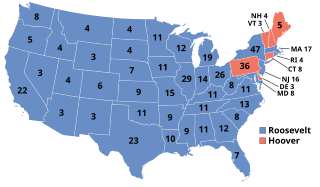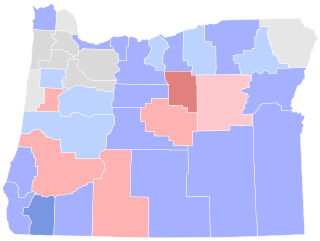
Presidential elections were held in the United States from October 30 to December 2, 1812. In the shadow of the War of 1812, incumbent Democratic-Republican President James Madison defeated DeWitt Clinton, the lieutenant governor of New York and mayor of New York City, who drew support from dissident Democratic-Republicans in the North as well as Federalists. It was the first presidential election to be held during a major war involving the United States.

Presidential elections were held in the United States on November 8, 1932. Against the backdrop of the Great Depression, incumbent Republican President Herbert Hoover was defeated in a landslide by Democrat Franklin D. Roosevelt, the governor of New York and the vice presidential nominee of the 1920 presidential election. The election marked the effective end of the Fourth Party System, which had been dominated by Republicans, and it was the first time since 1916 that a Democrat was elected president.

Benjamin Gratz Brown was an American politician. He was a U.S. Senator, the 20th Governor of Missouri, and the Liberal Republican and Democratic Party vice presidential candidate in the presidential election of 1872.

Milton Jerrold Shapp was an American businessman and politician who served as the 40th governor of Pennsylvania from 1971 to 1979 and the first Jewish governor of Pennsylvania. He was also the first governor of Pennsylvania to be eligible for, and re-elected to, consecutive four-year terms per the 1968 Pennsylvania Constitution.

William Henry Meyer was an American politician and Member of the United States House of Representatives from Vermont.

The 1936 Republican National Convention was held June 9–12 at the Public Auditorium in Cleveland, Ohio. It nominated Governor Alfred Landon of Kansas for president and Frank Knox of Illinois for vice president.

United States gubernatorial elections were held on November 4, 2014, in 36 states and three territories, concurrent with other elections during the 2014 United States elections.

The 1934 Oregon gubernatorial election took place on November 6, 1934 to elect the governor of the U.S. state of Oregon. Democrat Charles H. Martin, who retired from the United States House of Representatives to run for governor, won a plurality over Republican Oregon State Senator Peter Zimmerman, Republican nominee Joe E. Dunne, also a state senator, and several minor candidates. Willis Mahoney unsuccessfully sought the Democratic nomination, while Rufus C. Holman unsuccessfully sought the Republican nomination. Oregon would not elect another Democratic governor until 1956. As of 2022, this is also the last gubernatorial election in which Malheur County supported the Democratic candidate.

The 1922 Pennsylvania gubernatorial election occurred on November 7, 1922. Incumbent Republican governor William Sproul was not a candidate for re-election. Republican candidate Gifford Pinchot defeated Democratic candidate John A. McSparran to become Governor of Pennsylvania. John Stuchell Fisher unsuccessfully sought the Republican nomination.

The 1926 Pennsylvania gubernatorial election occurred on November 2, 1926. Incumbent Republican governor Gifford Pinchot was not a candidate for re-election. Republican candidate John Fisher defeated Democratic candidate Eugene C. Bonniwell to become Governor of Pennsylvania. Edward E. Beidleman, Thomas Wharton Phillips Jr., and John K. Tener unsuccessfully sought the Republican nomination.

The 1930 Pennsylvania gubernatorial election occurred on November 4, 1930. Incumbent Republican governor John Stuchell Fisher was not a candidate for re-election. Republican candidate and former governor Gifford Pinchot defeated Democratic candidate John M. Hemphill to win a second, non-consecutive term as Governor of Pennsylvania.

The 1938 Pennsylvania gubernatorial election occurred on November 8, 1938. Incumbent Democratic governor George Howard Earle III was not a candidate for re-election. Republican candidate Arthur James defeated Democratic candidate Charles Alvin Jones to become Governor of Pennsylvania. Gifford Pinchot unsuccessfully sought the Republican nomination, while Thomas Kennedy unsuccessfully sought the Democratic nomination.
Governor Milton Shapp of Pennsylvania unsuccessfully sought the Democratic Party nomination for president of the United States in the 1976 election. Shapp won reelection as governor of Pennsylvania in the 1974 election, the first Pennsylvania governor to be elected to a second four-year term following an amendment permitting this in 1967, and had hoped to translate his relative popularity in Pennsylvania into the groundwork of a successful presidential campaign.

The 1872 Pennsylvania gubernatorial election occurred on October 8, 1872. Incumbent governor John W. Geary, a Republican, was not a candidate for re-election.

The 1882 Pennsylvania gubernatorial election occurred on November 7, 1882. Incumbent governor Henry M. Hoyt, a Republican, was not a candidate for re-election.

The 1886 Pennsylvania gubernatorial election occurred on November 2, 1886. Republican candidate James A. Beaver defeated Democratic candidate Chauncey Forward Black to become Governor of Pennsylvania. William A. Wallace unsuccessfully sought the Democratic nomination.

The 1890 Pennsylvania gubernatorial election occurred on November 4, 1890. Democratic candidate and former Governor Robert E. Pattison defeated Republican candidate George W. Delamater to become Governor of Pennsylvania.

The 1902 Pennsylvania gubernatorial election occurred on November 4, 1902. Republican candidate Samuel W. Pennypacker defeated Democratic candidate and former Governor Robert E. Pattison to become Governor of Pennsylvania. James Kerr and George W. Guthrie unsuccessfully sought the Democratic nomination.

From March 10 to May 19, 1936, voters of the Republican Party chose its nominee for president in the 1936 United States presidential election. The nominee was selected through a series of primary elections and caucuses culminating in the 1936 Republican National Convention held from June 9 to June 12, 1936, in Cleveland, Ohio.

The 1932 Illinois gubernatorial election was held on November 8, 1932. It saw the election of Democrat Thomas Donavan, who defeated incumbent Republican lieutenant governor Fred E. Sterling.






















